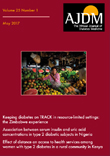Navigating postprandial hyperglycemia: Unveiling the after-meal glucose rollercoaster
*Corresponding Author:
Received: 02-Oct-2023, Manuscript No. ajdm-23-121969; Editor assigned: 04-Oct-2023, Pre QC No. ajdm-23-121969 (PQ); Reviewed: 18-Oct-2023, QC No. ajdm-23-121969 ; Revised: 23-Oct-2023, Manuscript No. ajdm-23-121969 (R); Published: 30-Oct-2023, DOI: 10.54931/AJDM-31.5.8.
Introduction
Managing diabetes is a delicate balance, and one of the crucial challenges faced by individuals with this condition is postprandial hyperglycemia, a phenomenon where blood glucose levels spike after meals. Understanding the intricacies of postprandial hyperglycemia is essential for effective diabetes management, as it plays a pivotal role in overall glycemic control. Postprandial hyperglycemia, often referred to as the “after-meal glucose rollercoaster,” is characterized by a rise in blood glucose levels after consuming food. This physiological response is part of the body’s natural digestive process, but in individuals with diabetes, it can become a significant concern if not properly managed. The primary driver of postprandial hyperglycemia is the digestion and absorption of carbohydrates. In individuals with diabetes, the body’s ability to regulate this process is compromised, resulting in elevated post-meal glucose levels.
Description
Insulin resistance, a common feature of type 2 diabetes, contributes to postprandial hyperglycemia. In these cases, the body’s cells do not respond effectively to insulin, hindering glucose uptake and leading to elevated blood sugar levels, particularly after meals. In some individuals, there may be a delay in insulin release in response to a meal. This delay allows blood glucose levels to rise before insulin can adequately facilitate glucose uptake by cells. Persistent postprandial hyperglycemia has been linked to an increased risk of cardiovascular disease. The elevated glucose levels can contribute to inflammation, endothelial dysfunction, and oxidative stress, all of which are factors associated with cardiovascular complications. Uncontrolled postprandial hyperglycemia can exacerbate insulin resistance, creating a vicious cycle that further impairs glucose metabolism and glycemic control. A fundamental aspect of managing postprandial hyperglycemia involves monitoring and controlling carbohydrate intake. Understanding the glycemic index of foods can help individuals make informed choices about the types and quantities of carbohydrates consumed. Spreading meals evenly throughout the day and avoiding large, infrequent meals can contribute to more stable blood glucose levels. Consistent meal timing helps synchronize insulin release with the anticipated rise in postprandial glucose. Regular physical activity has been shown to enhance insulin sensitivity and facilitate glucose uptake by cells. Incorporating exercise into daily routines can be an effective strategy for managing postprandial hyperglycemia. For individuals on diabetes medications, including insulin, healthcare providers may recommend adjustments to medication dosages or timing to address postprandial hyperglycemia. This tailored approach ensures that medications align with the individual’s specific needs. Postprandial hyperglycemia is a significant aspect of diabetes management, requiring a multifaceted approach that encompasses dietary choices, lifestyle modifications, and, when necessary, medication adjustments.
Conclusion
By proactively addressing the after-meal glucose rollercoaster, individuals with diabetes can enhance their overall glycemic control and reduce the risk of associated complications. Through continued research and personalized care, the journey towards effective postprandial glucose management holds promise for a healthier and more balanced life for those navigating the complexities of diabetes. In the quest for optimal diabetes management, the recognition of postprandial hyperglycemia as a pivotal factor underscores the importance of personalized care. Every individual’s response to meals is unique, influenced by factors such as metabolism, insulin sensitivity, and lifestyle. Therefore, a tailored approach that considers these individual nuances is essential for successful management.





